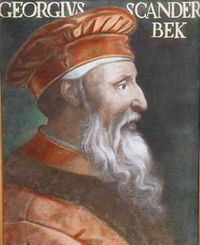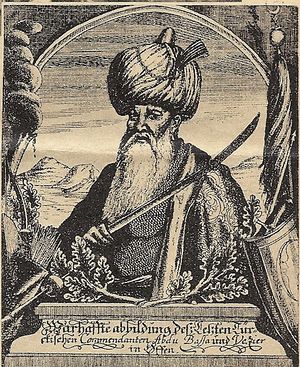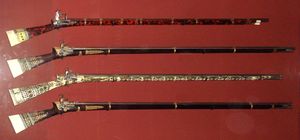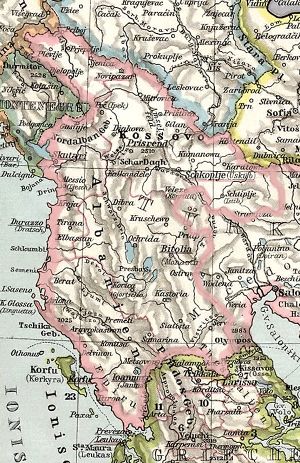ألبانيا العثمانية
| تاريخ ألبانيا |

قبل التاريخ
القـِدم
العصور الوسطى
ألبانيا العثمانية
بعد الاستقلال
ألبانيا المعاصرة
|
ألبانيا العثمانية comprised Albania during the period it was part of الدولة العثمانية، من 1385 حتى 1912. Ottoman rule in Albania began after the Battle of Savra in 1385 when most of the local chieftains became Ottoman vassals. The Ottomans erected their garrisons throughout southern Albania by 1415 and established formal jurisdiction over most of Albania by 1431. Independence for some Albanian regions was gained during 1443-1479, with the uprising under the lead of George Kastrioti Skanderbeg.[1] The last towns captured by the Ottomans were Shkodër in 1479 and Durrës in 1501. The territory which today belongs to the جمهورية ألبانيا ظلت جزءاً من الدولة العثمانية حتى أعلنت استقلالها في 1912 أثناء حروب البلقان.
. . . . . . . . . . . . . . . . . . . . . . . . . . . . . . . . . . . . . . . . . . . . . . . . . . . . . . . . . . . . . . . . . . . . . . . . . . . . . . . . . . . . . . . . . . . . . . . . . . . . . . . . . . . . . . . . . . . . . . . . . . . . . . . . . . . . . . . . . . . . . . . . . . . . . . . . . . . . . . . . . . . . . . . .
الحكم العثماني


The Ottomans expanded their empire from Anatolia to the Balkans in the 14th century. They crossed the Bosporus in 1352, and they crushed a Serbian army in the Battle of Maritsa in 1371 and Battle of Kosovo in 1389. Europe gained a brief respite from Ottoman pressure in 1402 when the Mongol leader, Tamerlane, attacked Anatolia from the east, killed the Turks' absolute ruler, the Sultan, and sparked a civil war.[2] When order was restored, the Ottomans renewed their westward progress. In 1453, Sultan Mehmed II's forces overran Constantinople and killed the last Byzantine emperor.[3]
The division of the Albanian-populated lands into small, quarreling fiefdoms ruled by independent feudal lords and tribal chiefs made them easy prey for the Ottoman armies. In 1385, the Albanian ruler of Durrës, Karl Thopia, appealed to the sultan for support against his rivals, the Balšić noble family. An Ottoman force quickly marched into Albania along the Via Egnatia and routed Balsha II in the Battle of Savra. The principal Albanian clans soon swore fealty to the Ottoman Empire. Gjirokastra became the county town of the Sanjak of Albania in 1419.[4] Sultan Murad II launched the major Ottoman onslaught in the Balkans in 1423, and the Turks took Ioannina in 1431 and Arta, on the Ionian coast, in 1449. The Turks allowed conquered Albanian clan chiefs to maintain their positions and property, but they had to pay tribute, send their sons to the Turkish court as hostages, and provide the Ottoman army with auxiliary troops.[3]
The Albanians' resistance to the Turks in the mid-15th century won them acclaim all over Europe. Gjon Kastrioti of Krujë was one of the Albanian clan leaders who submitted to Turkish suzerainty. He was compelled to send his four sons to the Ottoman capital to be trained for military service. The youngest, George Kastrioti (1403–68), who would become the Albanians' national hero, captured the sultan's attention. Renamed Iskander when he converted to Islam, the young man participated in military expeditions to Asia Minor and Europe. When appointed to administer a Balkan district, Iskander became known as Skanderbeg. After Ottoman forces under Skanderbeg's command suffered defeat in a battle near Niš in present-day Serbia in 1443, Skanderbeg rushed to Krujë and tricked a Turkish pasha into surrendering the Albanian fortress. Skanderbeg then embraced Roman Catholicism and declared a holy war against the Turks.[3]
Albanians also played a crucial role during the Ottoman–Venetian War (1499–1503), Ottoman–Hungarian Wars and Ottoman–Habsburg wars before gaining Independence.
القرن 18

القرن 19
Ottoman-Albanian relations worsened in the year 1826 during the reign of Mahmud II, he had instigated the notorious Auspicious Incident and the turmoil that followed caused the violent dissolution of the Janissary, Devşirme and the entire Balkan Muslim leadership in Rumelia causing a new wave of revolts and instability in the gradually weakening Ottoman Empire.
ضد تركيا الفتاة
نظام الحكم
Administratively, the Ottomans divided the Albanian-inhabited lands among a number of districts, or vilayets. The Ottoman authorities did not initially stress conversion to Islam.[6]
By 1479, the entire country, except for Durrës, Ulcinj and Bar, was under Ottoman suzerainty. Prominent viziers and pashas hailed from Albania, and were appointed to their posts long before the majority of Albanians professed Islam.
الاداري
- For details of : State Organization
الضرائب
الدين

الوطنية الألبانية
As a result of contacts maintained between the Tosks and their relatives living or returning from abroad, foreign ideas began to seep into Albania.
انظر أيضاً
الهامش
- ^ https://www.cia.gov/library/publications/the-world-factbook/geos/al.html
- ^ Dimitris J. Kastritsis, The Sons of Bayezid: Empire building and Representation in the Ottoman Civil War of 1402–1413, (BRILL, 2007), 1–3.
- ^ أ ب ت Raymond Zickel and Walter R. Iwaskiw (1994). "Albania: A Country Study ("The Ottoman Conquest of Albania")". Retrieved 9 April 2008.
- ^ Riza, Emin (1992). "Ethnographic and open-air museums" (PDF). UNESCO, Paris. Retrieved 18 March 2011.
- ^ Elsie 2010, "Flag, Albanian", p. 140: "The eagle was a common heraldic symbol for many Albanian dynasties in the Late Middle Ages and came to be a symbol of the Albanians in general. It is also said to have been the flag of Skanderbeg.... As a symbol of modern Albania, the flag began to be seen during the years of the national awakening and was in common use during the uprisings of 1909-1912."
- ^ Raymond Zickel and Walter R. Iwaskiw (1994). "Albania: A Country Study ("Albanians under Ottoman Rule")". Retrieved 9 April 2008.
. . . . . . . . . . . . . . . . . . . . . . . . . . . . . . . . . . . . . . . . . . . . . . . . . . . . . . . . . . . . . . . . . . . . . . . . . . . . . . . . . . . . . . . . . . . . . . . . . . . . . . . . . . . . . . . . . . . . . . . . . . . . . . . . . . . . . . . . . . . . . . . . . . . . . . . . . . . . . . . . . . . . . . . .
الأدبيات
- Elsie, Robert (2010). Historical Dictionary of Albania. Lanham, Maryland: Scarecrow Press (The Rowman & Littlefield Publishing Group Incorporated). ISBN 0-8108-6188-7.
{{cite book}}: Invalid|ref=harv(help)








